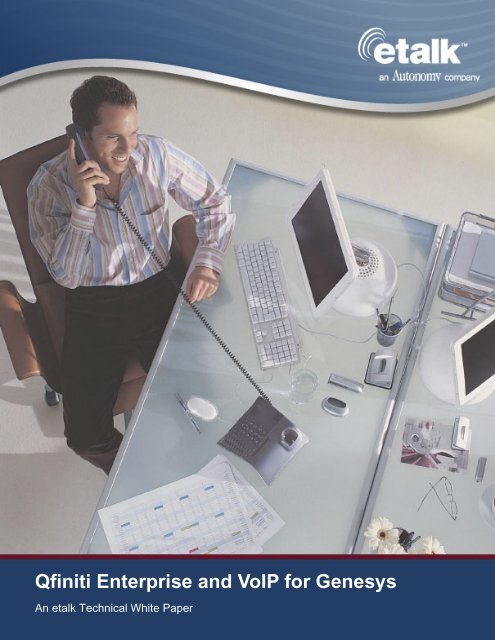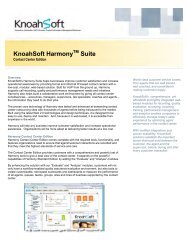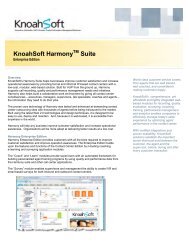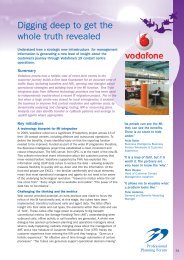Qfiniti Enterprise and VoIP for Genesys - QPC
Qfiniti Enterprise and VoIP for Genesys - QPC
Qfiniti Enterprise and VoIP for Genesys - QPC
You also want an ePaper? Increase the reach of your titles
YUMPU automatically turns print PDFs into web optimized ePapers that Google loves.
etalk Product BriefingIn today's increasingly competitive environment, customer satisfaction is more important thanever. Customers now dem<strong>and</strong> faster <strong>and</strong> more effective responses to their service needs.Organizations that can capture <strong>and</strong> analyze business communications - <strong>and</strong> use that intelligenceto boost customer loyalty <strong>and</strong> improve contact center productivity - have a clear advantage intheir marketplace.Now you can give your business that keen competitive edge with etalk <strong>Qfiniti</strong> Observe.<strong>Qfiniti</strong> Observe puts today's most powerful call recording capabilities at your fingertips. Thissolution gives you the option to record all your customer interactions, or lets you determine whichcalls to automatically monitor. It supports on-dem<strong>and</strong> recording of conversations <strong>and</strong> computerdesktop activities. In addition, it delivers full logging <strong>for</strong> financial <strong>and</strong> other critical complianceapplications. Featuring synchronized screen <strong>and</strong> voice recording <strong>and</strong> playback, <strong>Qfiniti</strong> Observecaptures <strong>and</strong> stores every aspect of your agents' interaction with a customer <strong>for</strong> easy evaluation.etalk’s <strong>Qfiniti</strong> Observe provides simple installation, a lower cost of ownership, <strong>and</strong> the ability toscale to meet your growing service requirements.Solid, long-lasting customer relationships are a key strategic investment. Now you can protectthat investment <strong>and</strong> keep your customers satisfied with etalk <strong>Qfiniti</strong> Observe.Integration OverviewFor quality monitoring recording, <strong>Qfiniti</strong> Observe integrates with legacy ACD/PBXs by emulating ast<strong>and</strong>ard supervisor phone. Through this emulation, <strong>Qfiniti</strong> Observe utilizes the “serviceobservation” functionality of the ACD to record the agent’s voice interactions with a customer.Screen capture is achieved using our agent client application. Agent Monitor Engine captures thescreen changes <strong>and</strong> sends them to the server to be saved with the voice recording.Voice over IP (<strong>VoIP</strong>) based ACDs, or “soft switches,” present a new challenge to this integrationmethod. Because it does not contain a centralized switch like legacy ACDs, the serviceobservation model is difficult, <strong>and</strong> in some cases impossible, to implement. etalk overcomes thischallenge by tapping the network <strong>and</strong> recording the RPT traffic <strong>for</strong> targeted <strong>VoIP</strong> phones usingetalk’s innovative recording plat<strong>for</strong>m, <strong>Qfiniti</strong> <strong>Enterprise</strong>.<strong>Qfiniti</strong> <strong>Enterprise</strong> <strong>and</strong> <strong>VoIP</strong> 3
<strong>VoIP</strong> Connectionetalk’s <strong>VoIP</strong> recording solution uses a packet recording technology that “sniffs” the network <strong>and</strong>records RTP packets <strong>for</strong> user-defined target phones.Using etalk’s innovative solution set, <strong>Qfiniti</strong> Observe translates extension numbers into the(DHCP) assigned IP addresses. This solution keeps the user from managing or configuringcomplicated translation tables <strong>and</strong> <strong>for</strong>cing customers to use static IP addressing schemes <strong>for</strong>their IP phones.Use of the IP-based sniffing allows the customer to position the recording plat<strong>for</strong>m in one of threepossible solutions. The first is at the Gateway (or between two layer 2 devices) using st<strong>and</strong>ardnetwork tapping devices; the second is in Core Routing (between layer 2 <strong>and</strong> layer 3) usingst<strong>and</strong>ard network tapping devices; <strong>and</strong> third is at the Edge Routing (via “Span” or “Mirror” ports).<strong>Genesys</strong> SIP ServerFigure 5: <strong>Genesys</strong> LAN Tapping Positions4 <strong>Qfiniti</strong> <strong>Enterprise</strong> <strong>and</strong> <strong>VoIP</strong>
Layer 2 ConnectivityPositioning the <strong>Qfiniti</strong> Recording Servers at the Media Gateway or inside Core Routing allows thecustomer to centralize the recording interfaces <strong>and</strong> to manage these interfaces in the data center.This implementation is per<strong>for</strong>med using st<strong>and</strong>ard network tap devices from companies likeDataCom Systems or NetOptics. These devices provide a passive monitor point from which<strong>Qfiniti</strong> Observe can sniff the network. Multiple network tap devices can be installed <strong>and</strong>connected to a single <strong>Qfiniti</strong> Record Server, allowing it to see traffic <strong>for</strong> primary <strong>and</strong> secondarynetwork routes.SPAN/RSPAN ConnectivityNetwork switches have a feature called a SPAN port. SPAN ports monitor network traffic <strong>and</strong>/orsniff the network, then send the data to a destination port. Span (or Local SPAN) is used whenboth the source ports (or source LVANs) <strong>and</strong> destination ports are on the same switch or switchstack.RSPAN ports can also be configured <strong>and</strong> utilized if necessary. RSPAN supports source ports (orsource LVANs) <strong>and</strong> destination ports on different switches or different switch stacks.Signaling ProtocolAs with all switch integrations, underst<strong>and</strong>ing when to start <strong>and</strong> stop recording is vital <strong>for</strong> thesolution to create recordings that contain the agent conversation from beginning to end. For<strong>Genesys</strong> <strong>VoIP</strong> integrations, <strong>Qfiniti</strong> Observe decodes the <strong>Genesys</strong> SIP <strong>and</strong> extracts the phone’soff-hook <strong>and</strong> on-hook phone events. These phone events translate into start <strong>and</strong> stop recordingmessages that provides a highly reliable interface <strong>for</strong> this switch integration.CTI Integration<strong>Qfiniti</strong> can also connect to the <strong>Genesys</strong> Tserver. The CTI link is used to identify the agent who issitting at the phone <strong>and</strong> to attach CTI based metadata to the recording. These metadata fieldscan be used as search criteria to find, retrieve, <strong>and</strong> play back calls using the <strong>Qfiniti</strong> <strong>Enterprise</strong> 3.0intuitive user interface.<strong>Qfiniti</strong> <strong>Enterprise</strong> <strong>and</strong> <strong>VoIP</strong> 5
Figure 1: <strong>Qfiniti</strong> 3.0 User InterfaceRecording Modes<strong>Qfiniti</strong> Observe can trigger records in four different ways. They are: Quality Plans, Record-on-Dem<strong>and</strong>, Global Plans <strong>and</strong> Continuous Record. All four of these recording methods can workindependently or together, providing unmatched recording capabilities. These modes can beimplemented using legacy ACD or <strong>VoIP</strong> connectivity.Quality PlansThis recording mode r<strong>and</strong>omly tags recordings based on the agents who receive the calls. Planscan be setup to record voice, voice <strong>and</strong> PC screens, or PC screens only. The plan can be set upto automatically schedule <strong>and</strong> record; <strong>for</strong> example, you may want to record three calls per agentper week. The plan can also be configured to delete recordings that age past a predeterminedtime frame, which frees up disk space <strong>for</strong> new recordings. This recording mode is generally usedto per<strong>for</strong>m quality assurance functions.6 <strong>Qfiniti</strong> <strong>Enterprise</strong> <strong>and</strong> <strong>VoIP</strong>
Global PlansThis recording mode, also known as Business Rules, tags recordings based on the type of callsthat arrive in your contact center. In this mode, the system tags calls when predefined CTI data isreceived from the IPCC. For instance, you may want to tag five calls per hour when the systemidentifies that a Gold Card customer is calling. The system can be set up to record a certainnumber calls per hour, per day, or per rule, as well as an unlimited number of calls (tag all calls<strong>for</strong> the rule). This recording mode is normally used <strong>for</strong> agenda management (i.e., evaluation of acampaign or a sales promotion).Record-on-Dem<strong>and</strong>This recording mode records calls when requested by an agent or supervisor or when triggeredby an application such as EasyLink. In this mode, the system simply tags recordings when told. Afully supported API or our API-less application, EasyLink, can be used when integrating into acustomer’s application environment.Our Agent Monitor Engine (agent client) <strong>and</strong> <strong>Qfiniti</strong> Desktop (supervisor client) software packagefeatures user interfaces that provide Record-on-Dem<strong>and</strong> functionality. This recording mode isnormally used <strong>for</strong> sales <strong>and</strong>/or process verification.Continuous RecordThis recording mode, also known as Logging or 100% recording, records all of the calls thatconnect to a station (phone) or a trunk. This recording mode is normally used <strong>for</strong> liability orcompliancy recording.PlaybackRegardless of where, how, or why a call is recorded, <strong>Qfiniti</strong> Observe reassembles the Receive(RX) <strong>and</strong> Transmit (TX) portions of the RTP packets into a single voice-recording file. This file isthen ready to be played back using <strong>Qfiniti</strong> Observe’s GUI based voice/video file player or througha touchtone user interface.<strong>Qfiniti</strong> <strong>Enterprise</strong> <strong>and</strong> <strong>VoIP</strong> 7
Conclusionetalk <strong>Qfiniti</strong> Observe’s flexible recording drivers <strong>and</strong> connectivity options provide customers with amultitude of call monitoring capabilities. By utilizing <strong>Qfiniti</strong> Observe’s reliable call logging <strong>and</strong>quality assurance functionality, corporations can focus on the customer <strong>and</strong> not the process.<strong>Qfiniti</strong> Observe allows organizations to maximize their investment in the etalk solution <strong>and</strong> solidifytheir investment in their customer relationships.8 <strong>Qfiniti</strong> <strong>Enterprise</strong> <strong>and</strong> <strong>VoIP</strong>
Glossary of Terms<strong>Qfiniti</strong> Observe – a <strong>Qfiniti</strong> <strong>Enterprise</strong> product that records voice <strong>and</strong> desktop activities <strong>for</strong>compliance, risk management, <strong>and</strong> quality assurance. Recording options include trunk sidelogging, station side logging, <strong>and</strong> selective recording.ACD (Automatic Call Distributor) – Automatically distributes calls to agent terminals.Legacy ACD – TDM -based monolithic telephony switch; connects <strong>and</strong> controls connectionsbetween terminal devices (phones) <strong>and</strong> the Public Switch Telephone Network (PSTN).PBX (Private Branch eXchange) –a TDM based Telephone switch (see Legacy ACD) with limitedcall routing capabilities.Agent Monitor Engine – etalk’s agent client software component responsible <strong>for</strong> screenrecording.<strong>VoIP</strong> (Voice over Internet Protocol) – the routing of voice conversations through the Internet orother IP-based network.RTP (Real-time Transport Protocol) – a st<strong>and</strong>ardized packet <strong>for</strong>mat <strong>for</strong> delivering audio (voice)over the data network.Sniffing – the intercepting of log traffic passing over a digital network by computer software.Sniffing can be used to analyze network problems, detect intrusion, <strong>and</strong> monitor network usage.DHCP (Dynamic Host Configuration Protocol) – a set of rules used by a communications device(i.e., computer, router) that allow the device to request <strong>and</strong> obtain an IP address from a server.SPAN (Switch Port ANalyzer) port –Span or mirror port. SPAN copies or mirrors traffic receivedor sent (or both) on source ports or source VLANs to a destination port <strong>for</strong> analysis or recording.RSPAN port –SPAN that supports source ports, source VLANs, <strong>and</strong> destination ports on differentswitches or different switch stacks, enabling remote monitoring of multiple switches across anetwork.Call control protocol – a set of comm<strong>and</strong>s protocol used to control the phones’ call capabilities.<strong>Qfiniti</strong> <strong>Enterprise</strong> <strong>and</strong> <strong>VoIP</strong> 9
SIP (Session Integrated Protocol) – integrated messaging system; provides agents with instantaccess to experts within or outside of the contact centerCTI (Computer Telephony Integration) – a technology that allows interactions on a telephone <strong>and</strong>a computer to be integratedSignaling Protocol – the protocol used to establish <strong>and</strong> terminate a phone call over an IPnetwork.CTI Integration – combining customer contact channels (voice, email, fax, etc.) with computersystems, usually through computer software known as middleware.EasyLink – an aspect of <strong>Qfiniti</strong> Observe that establishes a direct connection between desktopapplications <strong>and</strong> the call recording program; contains a web-based user interface.API (Application Programming Interface) – the interface that computer applications use to accessa set of (usually third party) functions without requiring the source code of the functions.10 <strong>Qfiniti</strong> <strong>Enterprise</strong> <strong>and</strong> <strong>VoIP</strong>
<strong>Qfiniti</strong> <strong>Enterprise</strong> <strong>and</strong> <strong>VoIP</strong> 11







